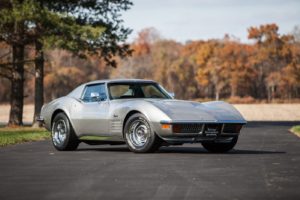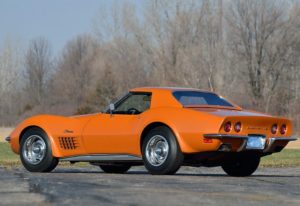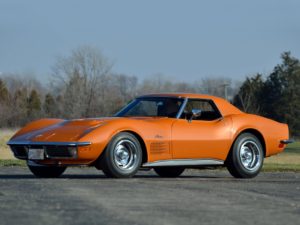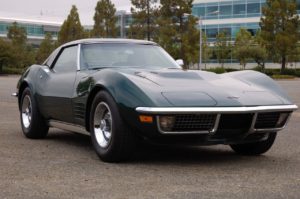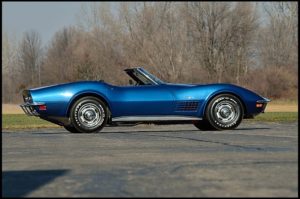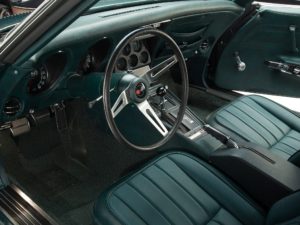The 1971 Chevy Corvette remains one of the least changed models in design (when compared to the preceding model year) in the Corvette’s entire production history.
The United Auto Workers (UAW) labor dispute that occurred in May 1969, which had caused the 1969 model year to run over by two months, had also shorted production of the 1970 Corvette by over four months.
Because of this, it was decided by Chevrolet management that they should treat the 1971 model year as an extension of the 1970 line, which meant that the Corvette – for better or worse – would remain essentially unaltered between the two model years
Pricing: $5,496.00 (Coupe), $5,259.00 (Convertible)
Engine options: 350cim – 270HP Engine (standard), 350ci – 330HP Engine, 454ci – 365HP Engine, 454ci – 425HP Engine
Transmission: 3-speed manual (standard), 4-speed manual (optional), 3-speed Turbo Hydra-Matic automatic (optional)
Top speed: 152mph
Units Produced: 21,801
Available Colors: Nevada Silver, Sunflower Yellow, Classic White, Mille Miglia Red, Mulsanne Blue, Bridgehampton Blue, Brands Hatch Green, Ontario Orange, Steel Cities Gray, War Bonnet Yellow
Highlights of the year:
The 1971 Corvette’s arrival also came in conjunction with a flurry of new federal regulations that forced manufacturers to reassess the types of cars they were producing.
In addition to the Federally-sanctioned mandates on reducing exhaust emission outputs, Edward Cole (who was now president of General Motors) had decreed that all 1971 GM cars would be capable of running on fuel with a Research Octane Number (RON) no higher than 91 Octane
According to Cole’s calculations, this octane rating was low enough for the fuel companies to begin marketing the lead-free regular gasoline needed to avoid fouling catalytic “reactors” (known as converters today) that were going to be required automobile engines. This reduction in fuel octane rating would translate into a reduction in engine compression (now just 8.5:1) and horsepower (a mere 270 bhp in the stock 350 engine.)
Somewhat surprisingly, these sanctioned emissions and fuel requirement changes didn’t only impact Corvette’s base engine. To the contrary, a notable reduction in compression – and power – was seen on almost all of the engines offered in the 1971 Corvette. The solid lifter, small block LT1 engine, which had boasted 370 horsepower in 1969, was now rated at a more modest 330 horsepower with a 9.0:1 compression ratio. The big-block engines also received the same treatment. The LS5 454 cubic inch big-block came equipped with 365 horsepower at 4800 rpm, and a new aluminum-head big-block engine identified as the LS6 was rated at 425 horsepower at 5600 rpm. Given the output numbers of these engines, there were few who would argue that the 1971 Corvette was weak, although most would agree that it was a far cry from the Corvettes that emerged in the unregulated era of muscle car performance.
According to Cole’s calculations, this octane rating was low enough for the fuel companies to begin marketing the lead-free regular gasoline needed to avoid fouling catalytic “reactors” (known as converters today) that were going to be required automobile engines. This reduction in fuel octane rating would translate into a reduction in engine compression (now just 8.5:1) and horsepower (a mere 270 bhp in the stock 350 engine.)
Somewhat surprisingly, these sanctioned emissions and fuel requirement changes didn’t only impact Corvette’s base engine. To the contrary, a notable reduction in compression – and power – was seen on almost all of the engines offered in the 1971 Corvette. The solid lifter, small block LT1 engine, which had boasted 370 horsepower in 1969, was now rated at a more modest 330 horsepower with a 9.0:1 compression ratio. The big-block engines also received the same treatment. The LS5 454 cubic inch big-block came equipped with 365 horsepower at 4800 rpm, and a new aluminum-head big-block engine identified as the LS6 was rated at 425 horsepower at 5600 rpm. Given the output numbers of these engines, there were few who would argue that the 1971 Corvette was weak, although most would agree that it was a far cry from the Corvettes that emerged in the unregulated era of muscle car performance.
Because of Cole’s far-reaching directive, Chevrolet engineers had only a matter of weeks rather than months to adjust all of their engines – and not just those for the Corvette. Because of this, very few changes were made to the 1971 Corvette – other than those made to the engines.
With production now recovered from the UAW strike, sales of the 1971 Corvette improved, resulting in a total of 21,801 Corvettes sold for that model year, with the coupe taking a 2 to 1 sales lead over the convertible – a result which many believed was the result of the C3’s introduction of T-tops in 1969. Prior to that point, Corvette convertibles had actually dominated sales, but starting in 1969, more coupes than convertibles were sold with each model year that passed.
In 1971, the result was total coupes to just 7,121 convertibles – a fact that GM would take under serious consideration in the years to come, and also a fact that would lead to a shocking, and some consider controversial decision for the 1976 model year.
Photos of the 1971 Corvette:
Sources:
https://www.corvsport.com/1971-c3-corvette/
https://www.corvsport.com/1971-c3-corvette-image-gallery/
